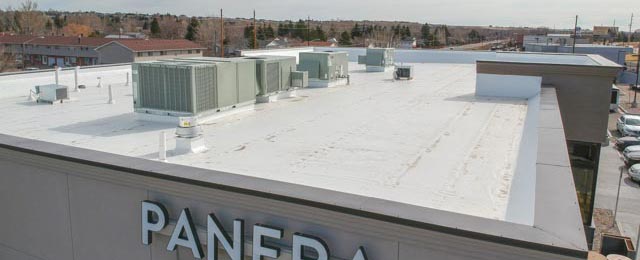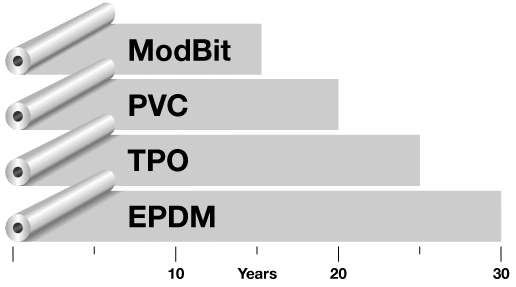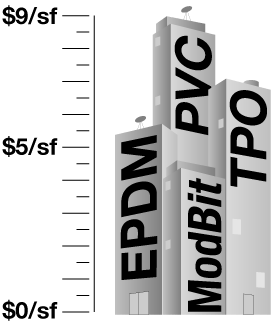If you have a commercial building, or a residential structure with a flat roof, our commercial roofing guide can help you. Maybe you’re researching a new flat roof system, or you need to replace or repair an existing one, and you’re wondering which one lasts longer or is the least expensive. That information, and more, is here. Call or email us, if you have any questions.
Table of Contents
- What a Flat Roof is
- How a Commercial Roof Differs From a Residential Roof
- Why You Might Want a Flat Roof
- What is the Cost to Install a Flat Roof
- Flat Roof Advantages and Disadvantages
- Flat Roof Systems Advantages and Disadvantages
- What Are the Flat Roof Systems
- The Life Expectancy of the Various Commercial Roof Systems
- What Are the Pros and Cons of PVC, TPO, EPDM and Modified Bitumen
- Which Flat Roof System is the Best
What is a Flat Roof?

A flat roof is a roof that only appears flat. In fact, so-called flat roofs have about a 2% pitch or slope to them. Flat roofs are most often installed on commercial buildings, which is why they are frequently referred to as ‘commercial roofs’. However, flat roofs are not exclusively for commercial building. We have installed flat roof systems on several home additions and garages.
Flat commercial roofs differentiate from common steep-sloped residential roofs in that they have to perform different functions. For example, a commercial roof not only has to protect a building from the weather, but also often support heavy equipment such as large air conditioning units. For this reason, commercial roofs are often made differently and use different materials.
3 Key Points How a Commercial Roof is Different From a Residential Roof
Commercial roofs are often significantly larger than residential roofs and creating a highly sloped roof for a large commercial building is impractical from a construction standpoint.
Commercial roofs often have to support heavy equipment such as large air conditioning units. It’s much easier to install an air conditioning unit on a flat roof than a highly sloped roof.
Commercial buildings are often constructed with flat roofs instead of highly sloped roofs because flat roofs are cheaper to build.
Why Have a Flat Roof?
As mentioned above, the frameworks and decks are less expensive to build compared to traditional residential high-sloped roof frameworks. You also might want a flat roof if you want or need your building to have a lower profile. Maybe there’s a height limitation in your city or you need your commercial building to stay below power lines. If you need your building to have a lower slope, for example, if you need to install heavy equipment on it.

Flat Roof/Single-Ply Systems We Provide
There are several flat roof systems available today. However, here are the most popular ones, which we offer:
- PVC (polyvinyl chloride)
- TPO (thermoplastic polyolefin)
- EPDM (ethylene propylene diene monomer). Also known as a rubber roof.
- Modified Bitumen

PVC
PVC stands for polyvinyl chloride. It is a basically a type of plastic that holds-up very well to even extreme weather. Most restaurants choose a PVC roof because it is resistant to animal fat and grease. If you have a restaurant, you should have a PVC roof.
What are the Advantages of a PVC Roof?
PVC is inherently fire-resistant. Roofs using PVC are specifically engineered to be strong; 300+ pounds per square inch of breaking strength. PVC seems are stronger than the membrane itself. These roofs are energy efficient due to their light color. PVC is highly resistant to greases and animal fats.
What are the Disadvantages of a PVC Roof?
The only disadvantage, and it really isn’t a disadvantage, of PVC roofing is the cost. Not that it’s that expensive, but of the 3 single-ply membrane roofing materials, it is generally considered the more expensive of the flat roof options listed.

TPO
TPO stands for thermoplastic polyolefin. It is among the more affordable commercial roofing options. It is a reflective roofing membrane made from polyprophylene and ethylene-propylene rubber polymerized together. TPO roofing is popular among those in manufacturing, warehouses, department stores, office buildings, condos, medical and dental offices, hotels and motels.
What are the Advantages of a TPO Roof?
A TPO roof offers the best of both worlds; the low cost of EPDM, with durable seems like PVC. TPO is resistant to dirt, bacteria, algae. Because TPO is flexible, it is resistant to tears, punctures and impacts. TPO has fabric embedded within the membrane for strength. Because TPO is naturally white, it’s reflects light reducing your utility bill. What’s more, it’s recyclable.
What are the Disadvantages of a TPO Roof?
The only disadvantage of a TPO roof is that it’s still a relatively new product. Not all TPO roofs are created equal. Some TPO manufacturers are better than others. After extensive research, we’ve found that Mule-Hide, Versico and Genflex make a great TPO roofing material.

EPDM
EPDM stands for ethylene propylene diene monomer. EPDM is also known in the industry as a ‘rubber roof’. It is an extremely durable synthetic rubber roofing membrane most commonly used on low-slope commercial buildings.
What are the Advantages of an EPDM Roof?
People choose EPDM because it’s the most affordable of the single-ply roofing membranes. EPDM is not only the least expensive to purchase, it is also the least expensive to install and repair.
Of the 3 roof materials we offer, EPDM is the longest lasting at 30 years on average. EPDM has a high tensile-strength. Because it’s basically rubber, EPDM is lightweight by nature and doesn’t require additional roof deck support.
EPDM remains flexible when either hot or cold so it won’t crack or split when expanding or contracting. Our vendors make a superior EPDM product that is resistant to punctures.
Although no one in our area (Colorado Front Range) recycles EPDM material, it is made from recycled rubber and at the end of your EPDM roof’s cycle, it can re recycled again. Check your area for EPDM or rubber recycling centers.
What are the Disadvantages of an EPDM Roof?
Although EPDM is puncture resistant, it is not puncture proof. At the end of the day, it’s rubber. It’s either black or white – nothing exciting. An EPDM roof ballasted (covered) with rocks is a visual improvement. EPDM has a poor resistance to petroleum-based products.
Modified Bitumen
Also known as Mod Bit and ‘tar and gravel’, modified bitumen is asphalt that’s been strengthened with rubber or plastic, then adhered to fiberglass fibers. It comes on a roll. Although modified bitumen is more common around Colorado on homes, it is also an option for commercial roofing, which is why we mention it here.
What are the Advantages of a Modified Bitumen Roof?
ModBit expands and contracts with changing temperatures. It’s inexpensive. It only costs a little more than asphalt shingles. ModBit is resistant to tears and hail. Because it rolls-on, ModBit is easily repaired with patches. It’s wind resistant. It’s water resistant – oil and water don’t mix 🙂 With a white top layer, heat is reflected, so it’s energy efficient. ModBit is relatively low maintenance. It’s available in multiple colors to match popular asphalt shingle colors.
What are the Disadvantages of a Modified Bitumen Roof?
The primary disadvantage of modified bitument is its short lifespan of only 10-15 years. Of all the single-ply, low-sloped roofing materials listed here, it is the shortest-lived.
We are proud to install and repair roofing systems from the industry’s best brands:
Life Expectancy of a PVC, TPO, EPDM and Modified Bitumen
A PVC roof can last 20 years or more when installed correctly using today’s modern technology. TPO; 25 years. EPDM; 30 years. Modified Bitumen; 15 years. When a roof fails, it is often because it wasn’t installed properly. When properly installed, the seems are actually stronger than the membrane itself.

How Much Does it Cost to Install or Replace a Flat Roof?
The cost to install a commercial roof depends upon the insulation and recovery board underneath the membrane. The cost to replace a commercial roof also depends upon the condition of the existing roof, if the existing insulation and recovery board needs to be replaced, among other things. So, for our price comparison, let’s leave all that aside. Let’s assume you have a 2500 square foot commercial building. To install just the single-ply roofing membrane, here are some averages: Modified Bitumen: $4.25/sf ($11,000) EPDM: $5.50/sf ($15,000) TPO: $7.00/sf ($16,000) PVC: $8.50/sf ($20,000)

Flat Roof Advantages and Disadvantages
Flat Roof Advantages
The biggest advantage to flat roofs is pricing. Because flat roofing systems come on large rolls, it takes a lot less time to install and repair them.
Since the deck for flat roofs has less lumber, it costs less to build. Another flat roof advantage is more outside space. Because a flat roof is, well, mostly flat, you can use that rooftop space for cooling equipment, a deck, or a garden.
Another clear advantage of having a flat roof is the viability. Since they’re not as tall as most sloped roofs, you can see over them, such as to view our Rocky Mountains.
They are also safer to walk on since they are, well, almost flat. As compared to a sloped roof. See Roofing Material Options for your Roof’s Pitch.
Flat Roof Disadvantages
This is a matter of opinion, but some consider flat roofs less attractive, especially when next to a home with a sloped roof. Large flat surfaces tend to be less stable. Therefore, additional support is required in other areas, such as the walls or vertical supports, to make a flat roof more stable.
The big flat roof disadvantage is water drainage. More planning and construction is required for proper drainage with a flat roof. Because there’s no attic, there’s no inside space for storage or a guest room, etc.
There’s also less room for insulation with a flat roof since there’s no attic. See Flat Roof Advantages and Disadvantages for more information.
Summary of Flat Roof Systems Pros and Cons
| Roofing System | Pros | Cons |
|---|---|---|
| PVC | Fire and grease resistant Strong Durable Energy Efficient | Cost |
| TPO | Less expensive than PVC Durable Resistant to dirt, bacteria, algae Flexible Strong Reflective | Relatively new product Not resistant to fires and grease |
| EPDM | Cost Longevity Strength Lightweight Flexible Puncture resistant Recyclable | Not puncture proof Appearance Poor resistance to petroleum-based products |
| ModBit | Flexible Inexpensive Strong Easy to install and repair Wind and water resistant Energy efficient Low Colorful | Short lifespan Not fire and grease resistant |
If you’re wondering how you choose the right roof system for you and your needs, start by asking yourself if there will be a lot of cooking in the building.
So, Which Flat Roof System is the Best?
Which flat roof system is best depends upon your needs, your budget, and, maybe more importantly, your roof’s pitch. Generally speaking, TPO is commonly considered the best commercial roofing system. Most commercial building owners prefer TPO because it’s white and reflects heat. Even more, TPO has fabric embedded within the membrane for added strength. PVC is good for restaurants, hospitals, and schools because it’s resistant to greases and animal fats, and fire. EPDM is cheaper than TPO which is good for savings.
Any professional commercial roofer will be able to help you decide which commercial roofing system is right for you and your building. Choosing the right roofing system, whether for your home or commercial building, really isn’t difficult; it starts with one question…
- Choose PVC if you own a restaurant as it’s resistant to grease and animal fats.
- If you want lower utility bills, again choose PVC as it’s the most reflective.
- Because it’s fire resistant, PVC wins, again.
- If cost is the determining factor, choose either EPDM or modified bitumen as they are the least expensive.
The Bottom Line
We hope you found this Commercial Roofing Guide useful. Our primary intent is to share the common commercial roofing systems, the advantages and disadvantages of each, the life expectancy of each, and the average cost of each. The information here is based upon our own experience and research. We know the opinions of roofing contractors will vary. If you feel some information is incorrect or missing, please leave a comment below and let us know.
